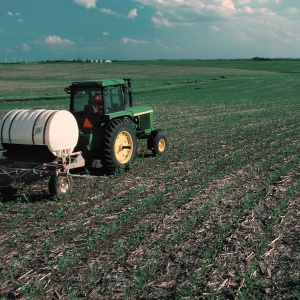
This paper outlines the main sustainability challenges linked to nitrogen, including inadequate access to nitrogen fertiliser in some parts of the world and excessive fertiliser application in other areas, leading to water pollution, algal blooms and risks to human health. The paper argues that solving nitrogen problems would have co-benefits for other sustainability issues such as hunger, air, soil and water quality, climate and biodiversity.
The paper sets out five priorities for solving challenges related to nitrogen:
- Improve the efficiency of nitrogen use in producing food, fibre and fuel, e.g. by using slow-release fertilisers, conserving soil through no-till agriculture, and using sensors to monitor nitrogen levels around plant roots.
- Improving access to nitrogen fertilisers where it is currently inadequate, e.g. in parts of sub-Saharan Africa. Government subsidies could be used to mitigate cost barriers. Increasing access to fertilisers should be implemented as part of a broader push towards restoring ecosystems and improving food security.
- Remove nitrogen pollution from the environment, e.g. through wetland restoration projects where vegetation converts nitrogen fertiliser runoff to biomass or harmless dinitrogen gas, construction of microbial bioreactors in field drainage networks, or through catalytic converters to reduce nitrogen air pollution from engines.
- Reduce food waste to reduce both unnecessary nitrogen fertiliser use and other environmental damage resulting from the growing of more food than required.
- Encourage diets with a low “nitrogen footprint”. The paper notes that beef, on average, retains less than 10% of the nitrogen fertiliser initially applied to grow crops for feed. However, further research on different growing methods and communication of those results to the public are required to help people choose diets that are consistent with both health and environmental goals.
Abstract
Nitrogen is a critical component of the economy, food security, and planetary health. Many of the world's sustainability targets hinge on global nitrogen solutions, which, in turn, contribute lasting benefits for (i) world hunger; (ii) soil, air, and water quality; (iii) climate change mitigation; and (iv) biodiversity conservation. Balancing the projected rise in agricultural nitrogen demands while achieving these 21st century ideals will require policies to coordinate solutions among technologies, consumer choice, and socioeconomic transformation.
Reference
Houlton, B.Z., Almaraz, M., Aneja, V., Austin, A.T., Bai, E., Cassman, K.G., Compton, J.E., Davidson, E.A., Erisman, J.W., Galloway, J.N. and Gu, B., 2019. A world of cobenefits: Solving the global nitrogen challenge. Earth's future, 7(8), pp. 865-872.
Read the full paper here. See also the Foodsource resource How do food systems contribute to water pollution?












Post a new comment »